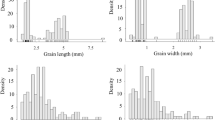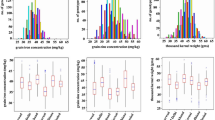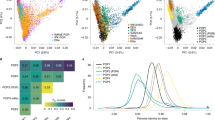Abstract
The reciprocal monosomic analysis (RMA) technique of intervarietal chromosome manipulation was used to investigate the genetic control of grain weight in two varieties of wheat (Spica and Chinese Spring). The method enabled major genetic differences between the two varieties for this quantitative character to be assigned to individual chromosomes. The RMA was extended by the extraction of reciprocal disomic F3 families, of which individual ears were analysed at maturity for grain weight at each position within the ear. Chromosomes 1A, 1D and 7A of the large-grained parent, Spica, increased grain weight relative to the homologous chromosomes of the small-grained parent, Chinese Spring. The effect of chromosomes 1D and 7A were proportionately similar throughout the ear, while that of 1A was disproportionately greater in the distal florets of each spikelet. None of these differences involved simultaneous effects on grain number and thus could be considered to be specific genetic effects on grain growth.
Similar content being viewed by others
Article PDF
References
Bingham, J. 1967. Investigations of the physiology of yield in winter wheat, by comparison of varieties and by artificial variation in grain number per ear. J Agric Sci, 68, 411–422.
Bremner, P M, and Rawson, H M. 1978. The weights of individual grains of the wheat ear in relation to their growth potential, the supply of assimilate and interaction between grains. Aust J Plant Physiol, 5, 61–72.
Brocklehurst, P A. 1977. Factors controlling grain weight in wheat. Nature, 266, 348–349.
Jenner, C F. 1980. Effects of shading or removing spikelets in wheat: testing assumptions. Aust J Plant Physiol, 7, 113–122.
Kuspira, J, and Unrau, J. 1957. Genetic analysis of certain characters in wheat using whole chromosome substitution lines. Can J Plant Sci, 37, 300–326.
Kuspira, J, and Unrau, J. 1959. Theoretical ratios and tables to facilitate genetic studies with aneuploids. I. F1 and F2 analysis. Can J Genetics and Cytology, 1, 267–312.
Law, C N. 1967. The location of genetic factors controlling a number of quantitative characters in wheat. Genetics, 56, 445–461.
Law, C N, and Worland, A J. 1973. Aneuploidy in wheat and its uses in genetic analysis. In Plant Breeding Institute Annual Report, 1972, Cambridge, 25–65.
Law, C N, Snape, J W, and Worland, A. 1979. Reciprocal monosomic studies. In Plant Breeding Institute Annual Report, 1978, Cambridge, 134–135.
Law, C N, Snape, J W, and Worland, A J. 1981. Intraspecific chromosome manipulation. Phil Trans R Soc London B, 292, 509–518.
Lupton, F G H, and Kirby, E J M. 1968. Applications of physiological analysis to cereal breeding. In Plant Breeding Institute Annual Report, 1967, Cambridge, 5–26.
McEwan, J M, and Kaltsikes, P J. 1970. Early generation testing as a means of predicting the value of specific chromosome substitutions into common wheat. Can, J Genet Cytol, 12, 711–723.
Sears, E R. 1953. Nullisomic analysis in common wheat. Amer Nat, 87, 245–252.
Sears, E R. 1954. The aneuploids of common wheat. Mo Agric Exp Stn Res Bull. 572.
Simmons, S R, and Moss, D N. 1978. Nitrogen and dry matter accumulation by kernels formed at specific fiorets in spikelets of spring wheat. Crop Sci, 18, 139–143.
Wardlaw, I F, and Moncur, L. 1976. Source, sink and hormonal control of translocation in wheat (cv Gabo). Planta, 128, 93–100.
Author information
Authors and Affiliations
Rights and permissions
About this article
Cite this article
Chojecki, A., Bayliss, M. & Gále, M. Genetic analysis of grain weight in wheat. Heredity 57, 93–99 (1986). https://doi.org/10.1038/hdy.1986.92
Received:
Issue date:
DOI: https://doi.org/10.1038/hdy.1986.92



